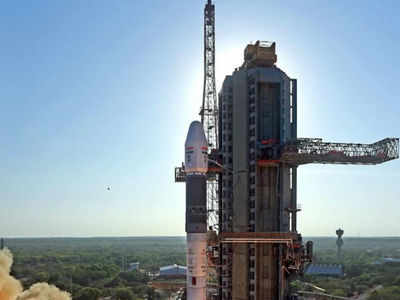- News
- India News
- Isro will launch Chandrayaan-2 in Oct 1st week after tests: Chief Dr K Sivan
Trending
This story is from March 25, 2018
Isro will launch Chandrayaan-2 in Oct 1st week after tests: Chief Dr K Sivan

Key Highlights
- Isro chief said, “The original targeted date for the launch was kept on April 23. However, as the ongoing tests for the lunar mission will take 20 more days."
- The Rs 800-crore Chandrayaan-2 mission is a totally indigenous mission
- Isro is focusing on the launch of its satellite Gsat-6A by GSLVF08 rocket on March 29
NEW DELHI: Indian Space Research Organisation’s Chandrayaan-2 mission, which was "originally scheduled for the April 23" will now be launched in the "first week of October".
Explaining the reason for postponing the lunar mission, Isro chairman Dr K Sivan told TOI, "Our panel of eminent space scientists comprising former Isro chairmen, top space experts and IIT professors has praised our preparations for the Chandrayaan-2 mission.However, keeping in mind the complexities involved in the mission as for the first time Isro is experimenting with a orbiter, a rover and a lander, the panel recommended postponing the launch till we complete all tests and are confident of a perfect mission."
Dr Sivan said, "The original targeted date for the launch was kept on April 23. However, as the ongoing tests for the lunar mission will take 20 more days, the April 23rd date could not be met. Therefore the panel decided to defer the launch. Unlike, other satellite launches where Isro could easily defer the launch by a day or two to get a perfect mission, Isro can’t do the same in this mission. This is because the ideal date for the moon launch comes only once in a month. If we skip that date of the month, we have to plan the launch next month. After skipping the April date, if Isro launches the mission in the months from May to September, we won’t be able to utilise the full lunar day (14 Earth days) for experiments on the moon because of eclipses and other reasons. Therefore, Isro will launch the mission in the first week of October."

During the 14 Earth days, the six-wheeled rover will have the power to move around 100-200 metre. The instruments, including a high-intensity camera, on the rover will observe the lunar surface and take images of the moon. It will send back data to the Earth via the orbiter within 15 minutes that will be useful for analysis of the lunar soil. Payloads of the 3,290kg Chandrayaan-2 spacecraft will collect scientific information on lunar topography, mineralogy, elemental abundance, lunar exosphere and signatures of hydroxyl and water-ice.
Soft-landing on the lunar surface is the most challenging part of the mission. Till now, only the US, Russia and China have been able to soft-land spacecraft on the lunar surface.
Gsat-6A launch on March 29: With the Chandrayaan-2 mission launch deferred, Isro is currently focusing on the launch of its communication satellite Gsat-6A by GSLV-F08 rocket on March 29. Gsat-6A, with a life span of 10 years, is a high-powered S-band communication satellite weighing 2,140 kg that will provide a platform for developing technologies that will be useful for satellite-based mobile communication.
Explaining the reason for postponing the lunar mission, Isro chairman Dr K Sivan told TOI, "Our panel of eminent space scientists comprising former Isro chairmen, top space experts and IIT professors has praised our preparations for the Chandrayaan-2 mission.However, keeping in mind the complexities involved in the mission as for the first time Isro is experimenting with a orbiter, a rover and a lander, the panel recommended postponing the launch till we complete all tests and are confident of a perfect mission."
Dr Sivan said, "The original targeted date for the launch was kept on April 23. However, as the ongoing tests for the lunar mission will take 20 more days, the April 23rd date could not be met. Therefore the panel decided to defer the launch. Unlike, other satellite launches where Isro could easily defer the launch by a day or two to get a perfect mission, Isro can’t do the same in this mission. This is because the ideal date for the moon launch comes only once in a month. If we skip that date of the month, we have to plan the launch next month. After skipping the April date, if Isro launches the mission in the months from May to September, we won’t be able to utilise the full lunar day (14 Earth days) for experiments on the moon because of eclipses and other reasons. Therefore, Isro will launch the mission in the first week of October."

The Rs 800-crore Chandrayaan-2 mission is a totally indigenous mission. Once the GSLV-F10 put the spacecraft in the 170 km x 20,000 km elliptical orbit, the orbiter would be manoeuvred towards the 100-km lunar orbit by firing thrusters and then the lander housing the rover will separate from the orbiter. After a controlled descent, the lander will soft-land near the south pole of the lunar surface and deploy the rover.
During the 14 Earth days, the six-wheeled rover will have the power to move around 100-200 metre. The instruments, including a high-intensity camera, on the rover will observe the lunar surface and take images of the moon. It will send back data to the Earth via the orbiter within 15 minutes that will be useful for analysis of the lunar soil. Payloads of the 3,290kg Chandrayaan-2 spacecraft will collect scientific information on lunar topography, mineralogy, elemental abundance, lunar exosphere and signatures of hydroxyl and water-ice.
Soft-landing on the lunar surface is the most challenging part of the mission. Till now, only the US, Russia and China have been able to soft-land spacecraft on the lunar surface.
Gsat-6A launch on March 29: With the Chandrayaan-2 mission launch deferred, Isro is currently focusing on the launch of its communication satellite Gsat-6A by GSLV-F08 rocket on March 29. Gsat-6A, with a life span of 10 years, is a high-powered S-band communication satellite weighing 2,140 kg that will provide a platform for developing technologies that will be useful for satellite-based mobile communication.
End of Article
FOLLOW US ON SOCIAL MEDIA










